stop start SKODA FABIA 2006 2.G / 5J Owner's Manual
[x] Cancel search | Manufacturer: SKODA, Model Year: 2006, Model line: FABIA, Model: SKODA FABIA 2006 2.G / 5JPages: 258, PDF Size: 44.86 MB
Page 29 of 258

Instruments and Indicator/Warning Lights28
Turn signal system
Either the left or right indicator light flashes depending on the position of the turn signal lever.
The indicator light flashes at twice its normal rate if a turn signal light fails. This does not apply when towing a trailer.
Switching off the hazard warning light system is switched on will cause all of the turn signal lights as well as both indicator lights to flash.
Further information about the turn signal system ⇒page 60.
Main beam
The indicator light comes on when the main beam is selected or also when the headlight flasher is operated.
Further information about the main beam ⇒page 60.
Low beam
The indicator light comes on when low beam is selected ⇒page 56.
Rear fog light
The warning light comes on when the rear fog lights are operating ⇒ page 58.
Alternator
The warning light comes on after the ignition has been switched on. It should go out after the engine has started.
If the warning light does not go out after the engine has started, or comes on when driving, drive to the nearest specialist garage. The vehicle battery will be discharged in this case so switch off all non-essential electrical components.
The following text will be displayed in the information display*:
ALTERNATOR WORKSHOP!
Caution
If the warning light comes on when driving and in addition the warning light (cooling system fault) also comes on in display, you must then stop the car immediately and switch the engine off - risk of engine damage!
Fog lights*
The warning light comes on when the fog lights are operating ⇒page 58.
Cornering lights*
If the warning light flashes for 1 minute while driving or after switching on the ignition and a warning signal sounds, a fault is confirmed.
Further information ⇒page 57.
NKO A05Fabia 20.book Page 28 Tuesday, September 26, 2006 8:38 AM
Page 31 of 258
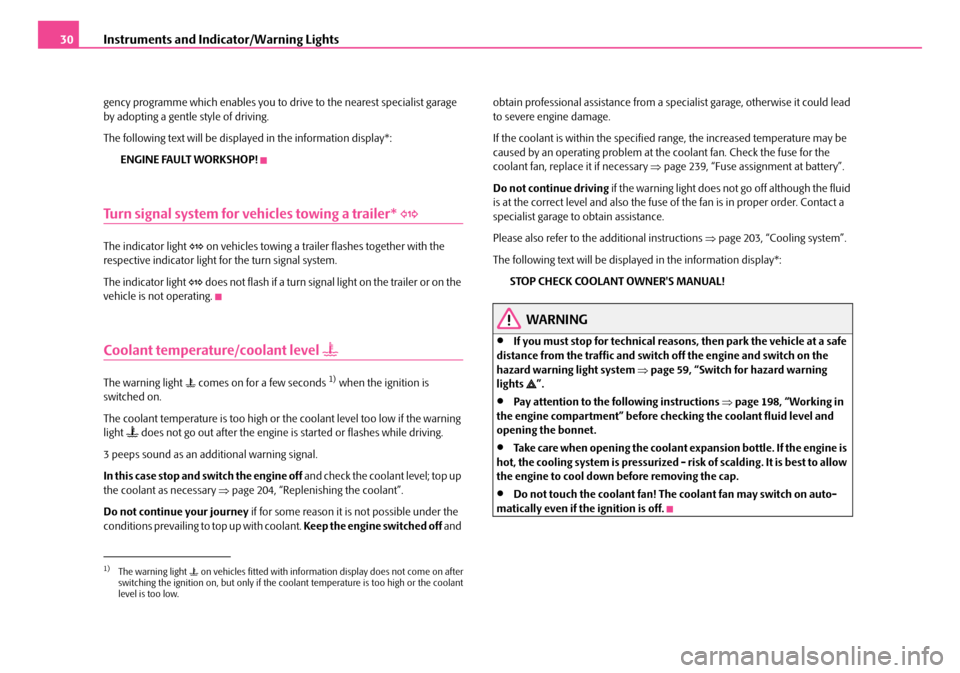
Instruments and Indicator/Warning Lights30
gency programme which enables you to drive to the nearest specialist garage by adopting a gentle style of driving.
The following text will be displayed in the information display*:
ENGINE FAULT WORKSHOP!
Turn signal system for ve hicles towing a trailer*
The indicator light on vehicles towing a trailer flashes together with the respective indicator light for the turn signal system.
The indicator light does not flash if a turn signal light on the trailer or on the vehicle is not operating.
Coolant temperature/coolant level
The warning light comes on for a few seconds 1) when the ignition is switched on.
The coolant temperature is too high or the coolant level too low if the warning light does not go out after the engine is started or flashes while driving.
3 peeps sound as an additional warning signal.
In this case stop and switch the engine off and check the coolant level; top up the coolant as necessary ⇒page 204, “Replenishing the coolant”.
Do not continue your journey if for some reason it is not possible under the conditions prevailing to top up with coolant. Keep the engine switched off and
obtain professional assistance from a specialist garage, otherwise it could lead to severe engine damage.
If the coolant is within the specified range, the increased temperature may be caused by an operating problem at the coolant fan. Check the fuse for the coolant fan, replace it if necessary ⇒page 239, “Fuse assignment at battery”.
Do not continue driving if the warning light does not go off although the fluid is at the correct level and also the fuse of the fan is in proper order. Contact a specialist garage to obtain assistance.
Please also refer to the additional instructions ⇒page 203, “Cooling system”.
The following text will be displayed in the information display*:
STOP CHECK COOLANT OWNER'S MANUAL!
WARNING
•If you must stop for technical reasons, then park the vehicle at a safe distance from the traffic and switch off the engine and switch on the hazard warning light system ⇒page 59, “Switch for hazard warning lights ”.
•Pay attention to the following instructions ⇒page 198, “Working in the engine compartment” before ch ecking the coolant fluid level and opening the bonnet.
•Take care when opening the coolant expansion bottle. If the engine is hot, the cooling system is pressurized - risk of scalding. It is best to allow the engine to cool down before removing the cap.
•Do not touch the coolant fan! The coolant fan may switch on auto- matically even if the ignition is off.
1)The warning light on vehicles fitted with information display does not come on after switching the ignition on, but only if the cool ant temperature is too high or the coolant level is too low.
NKO A05Fabia 20.book Page 30 Tuesday, September 26, 2006 8:38 AM
Page 32 of 258
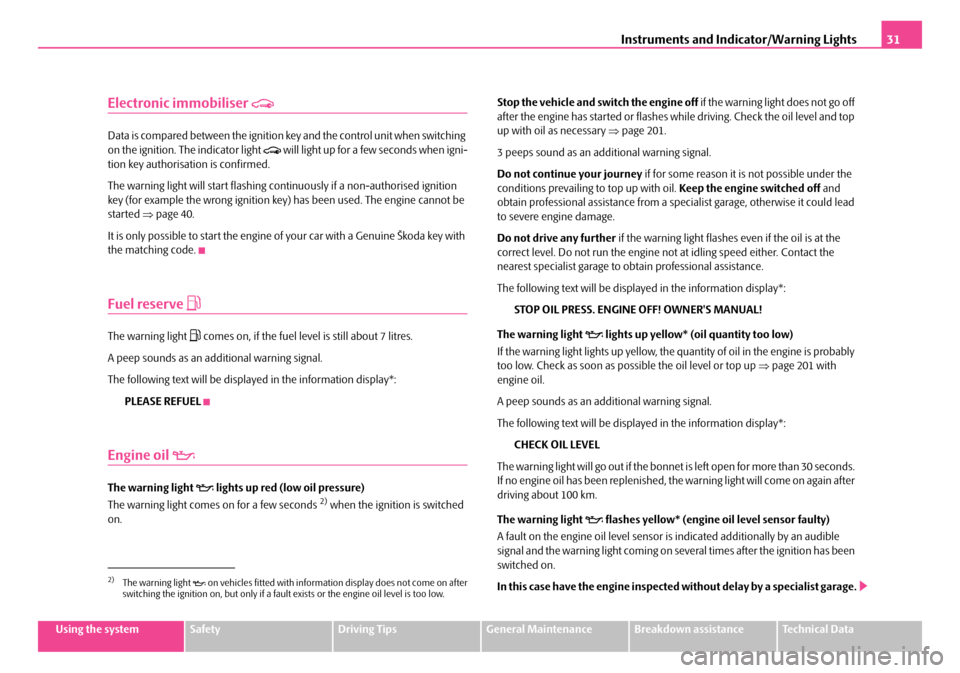
Instruments and Indicator/Warning Lights31
Using the systemSafetyDriving TipsGeneral MaintenanceBreakdown assistanceTechnical Data
Electronic immobiliser
Data is compared between the ignition key and the control unit when switching on the ignition. The indicator light will light up for a few seconds when igni- tion key authorisation is confirmed.
The warning light will start flashing cont inuously if a non-authorised ignition key (for example the wrong ignition key) has been used. The engine cannot be started ⇒page 40.
It is only possible to start the engine of your car with a Genuine Škoda key with the matching code.
Fuel reserve
The warning light comes on, if the fuel level is still about 7 litres.
A peep sounds as an additional warning signal.
The following text will be displayed in the information display*:
PLEASE REFUEL
Engine oil
The warning light lights up red (low oil pressure)
The warning light comes on for a few seconds 2) when the ignition is switched on.
Stop the vehicle and switch the engine off if the warning light does not go off after the engine has started or flashes while driving. Check the oil level and top up with oil as necessary ⇒page 201.
3 peeps sound as an additional warning signal.
Do not continue your journey if for some reason it is not possible under the conditions prevailing to top up with oil. Keep the engine switched off and obtain professional assistance from a specialist garage, otherwise it could lead to severe engine damage.
Do not drive any further if the warning light flashes even if the oil is at the correct level. Do not run the engine no t at idling speed either. Contact the nearest specialist garage to obtain professional assistance.
The following text will be displayed in the information display*:
STOP OIL PRESS. ENGINE OFF! OWNER'S MANUAL!
The warning light lights up yellow* (oil quantity too low)
If the warning light lights up yellow, the qu antity of oil in the engine is probably too low. Check as soon as pos sible the oil level or top up ⇒page 201 with engine oil.
A peep sounds as an additional warning signal.
The following text will be displayed in the information display*:
CHECK OIL LEVEL
The warning light will go out if the bonnet is left open for more than 30 seconds. If no engine oil has been replenished, th e warning light will come on again after driving about 100 km.
The warning light flashes yellow* (engine oil level sensor faulty)
A fault on the engine oil level sensor is indicated additionally by an audible signal and the warning light coming on se veral times after the ignition has been switched on.
In this case have the engine inspecte d without delay by a specialist garage.2)The warning light on vehicles fitted with information display does not come on after switching the ignition on, but only if a fault exists or the engine oil level is too low.
NKO A05Fabia 20.book Page 31 Tuesday, September 26, 2006 8:38 AM
Page 33 of 258
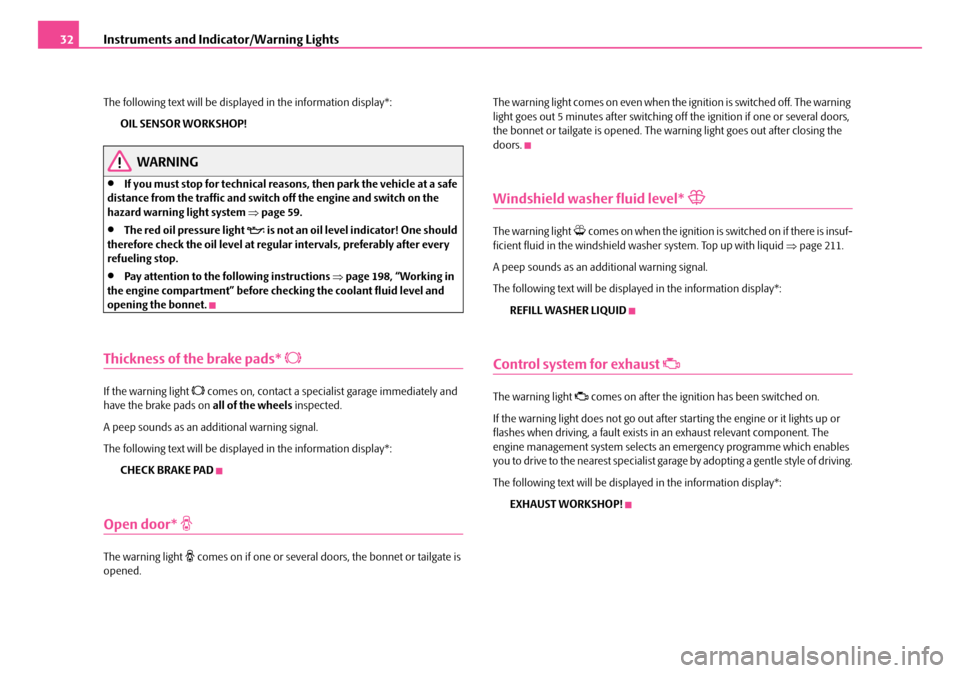
Instruments and Indicator/Warning Lights32
The following text will be displayed in the information display*:
OIL SENSOR WORKSHOP!
WARNING
•If you must stop for technical reasons, then park the vehicle at a safe distance from the traffic and switch off the engine and switch on the hazard warning light system ⇒page 59.
•The red oil pressure light is not an oil level indicator! One should therefore check the oil level at regular intervals, preferably after every refueling stop.
•Pay attention to the following instructions ⇒page 198, “Working in the engine compartment” before checking the coolant fluid level and opening the bonnet.
Thickness of the brake pads*
If the warning light comes on, contact a specialist garage immediately and have the brake pads on all of the wheels inspected.
A peep sounds as an additional warning signal.
The following text will be displayed in the information display*:
CHECK BRAKE PAD
Open door*
The warning light comes on if one or several doors, the bonnet or tailgate is opened.
The warning light comes on even when the ignition is switched off. The warning light goes out 5 minutes after switching off the ignition if one or several doors, the bonnet or tailgate is opened. The warning light goes out after closing the doors.
Windshield washer fluid level*
The warning light comes on when the ignition is switched on if there is insuf-ficient fluid in the windshield washer system. Top up with liquid ⇒page 211.
A peep sounds as an additional warning signal.
The following text will be displayed in the information display*:
REFILL WASHER LIQUID
Control system for exhaust
The warning light comes on after the ignition has been switched on.
If the warning light does not go out after starting the engine or it lights up or flashes when driving, a fault exists in an exhaust relevant component. The engine management system selects an emergency programme which enables you to drive to the nearest specialist gara ge by adopting a gentle style of driving.
The following text will be displayed in the information display*:
EXHAUST WORKSHOP!
NKO A05Fabia 20.book Page 32 Tuesday, September 26, 2006 8:38 AM
Page 34 of 258
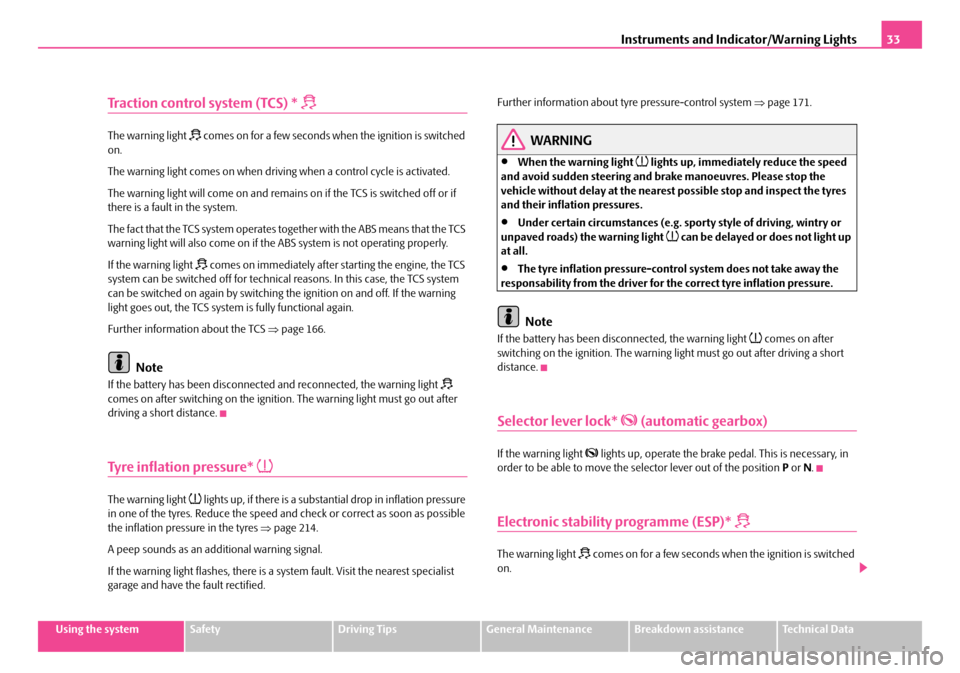
Instruments and Indicator/Warning Lights33
Using the systemSafetyDriving TipsGeneral MaintenanceBreakdown assistanceTechnical Data
Tr a c t i o n c o n t r o l system (TCS) *
The warning light comes on for a few seconds when the ignition is switched on.
The warning light comes on when drivin g when a control cycle is activated.
The warning light will come on and remains on if the TCS is switched off or if there is a fault in the system.
The fact that the TCS system operates together with the ABS means that the TCS warning light will also come on if the ABS system is not operating properly.
If the warning light comes on immediately after starting the engine, the TCS system can be switched off for technica l reasons. In this case, the TCS system can be switched on again by switching th e ignition on and off. If the warning light goes out, the TCS system is fully functional again.
Further information about the TCS ⇒page 166.
Note
If the battery has been disconnected and reconnected, the warning light comes on after switching on the ignition . The warning light must go out after driving a short distance.
Tyre inflation pressure*
The warning light lights up, if there is a substantial drop in inflation pressure in one of the tyres. Reduce the speed and check or correct as soon as possible the inflation pressure in the tyres ⇒page 214.
A peep sounds as an additional warning signal.
If the warning light flashes, there is a system fault. Visit the nearest specialist garage and have the fault rectified.
Further information about tyre pressure-control system ⇒page 171.
WARNING
•When the warning light lights up, immediately reduce the speed and avoid sudden steering and brak e manoeuvres. Please stop the vehicle without delay at the nearest possible stop and inspect the tyres and their inflation pressures.
•Under certain circumstances (e.g. sporty style of driving, wintry or unpaved roads) the warning light can be delayed or does not light up at all.
•The tyre inflation pressure-control system does not take away the responsability from the driver for the correct tyre inflation pressure.
Note
If the battery has been disconnected, the warning light comes on after switching on the ignition. The warning light must go out after driving a short distance.
Selector lever lock* (automatic gearbox)
If the warning light lights up, operate the brake pedal. This is necessary, in order to be able to move the selector lever out of the position P or N.
Electronic stability programme (ESP)*
The warning light comes on for a few seconds when the ignition is switched on.
NKO A05Fabia 20.book Page 33 Tuesday, September 26, 2006 8:38 AM
Page 35 of 258
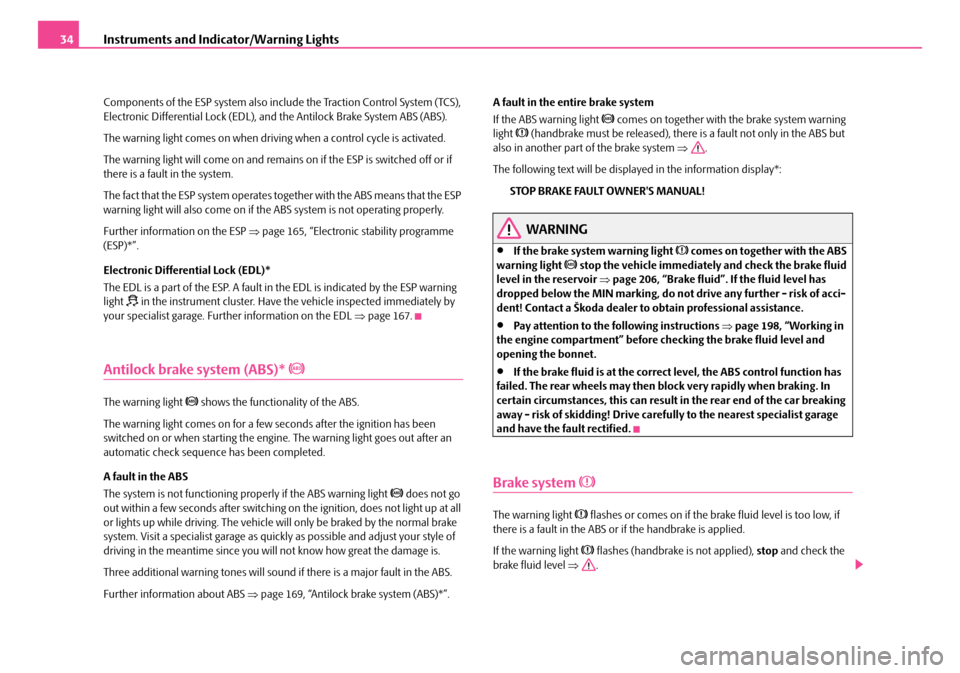
Instruments and Indicator/Warning Lights34
Components of the ESP system also include the Traction Control System (TCS), Electronic Differential Lock (EDL), and the Antilock Brake System ABS (ABS).
The warning light comes on when drivin g when a control cycle is activated.
The warning light will come on and remains on if the ESP is switched off or if there is a fault in the system.
The fact that the ESP system operates together with the ABS means that the ESP warning light will also come on if the ABS system is not operating properly.
Further information on the ESP ⇒page 165, “Electronic stability programme (ESP)*”.
Electronic Differential Lock (EDL)*
The EDL is a part of the ESP. A fault in the EDL is indicated by the ESP warning light in the instrument cluster. Have the vehicle inspected immediately by your specialist garage. Further information on the EDL ⇒page 167.
Antilock brake system (ABS)*
The warning light shows the functionality of the ABS.
The warning light comes on for a few seconds after the ignition has been switched on or when starting the engine. The warning light goes out after an automatic check sequence has been completed.
A fault in the ABS
The system is not functioning properly if the ABS warning light does not go out within a few seconds after switching on the ignition, does not light up at all or lights up while driving. The vehicle wi ll only be braked by the normal brake system. Visit a specialist garage as quickly as possible and adjust your style of driving in the meantime since you will not know how great the damage is.
Three additional warning tones will sound if there is a major fault in the ABS.
Further information about ABS ⇒page 169, “Antilock brake system (ABS)*”.
A fault in the entire brake system
If the ABS warning light comes on together with the brake system warning light (handbrake must be released), ther e is a fault not only in the ABS but also in another part of the brake system ⇒.
The following text will be displayed in the information display*:
STOP BRAKE FAULT OWNER'S MANUAL!
WARNING
•If the brake system warning light comes on together with the ABS warning light stop the vehicle immediatel y and check the brake fluid level in the reservoir ⇒page 206, “Brake fluid”. If the fluid level has dropped below the MIN marking, do not drive any further - risk of acci- dent! Contact a Škoda dealer to obtain professional assistance.
•Pay attention to the following instructions ⇒page 198, “Working in the engine compartment” before checking the brake fluid level and opening the bonnet.
•If the brake fluid is at the correct level, the ABS control function has failed. The rear wheels may then bloc k very rapidly when braking. In certain circumstances, this can result in the rear end of the car breaking away - risk of skidding! Drive carefu lly to the nearest specialist garage and have the fault rectified.
Brake system
The warning light flashes or comes on if the brake fluid level is too low, if there is a fault in the ABS or if the handbrake is applied.
If the warning light flashes (handbrake is not applied), stop and check the brake fluid level ⇒.
NKO A05Fabia 20.book Page 34 Tuesday, September 26, 2006 8:38 AM
Page 40 of 258
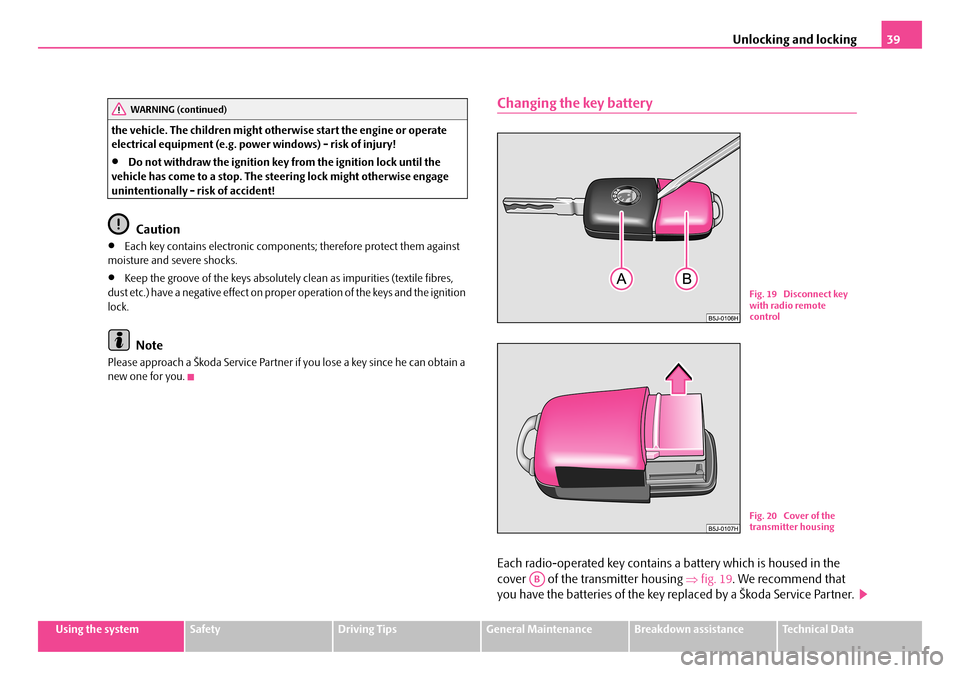
Unlocking and locking39
Using the systemSafetyDriving TipsGeneral MaintenanceBreakdown assistanceTechnical Data
the vehicle. The children might othe rwise start the engine or operate electrical equipment (e.g. power windows) - risk of injury!
•Do not withdraw the ignition key from the ignition lock until the vehicle has come to a stop. The st eering lock might otherwise engage unintentionally - risk of accident!
Caution
•Each key contains electronic compon ents; therefore protect them against moisture and severe shocks.
•Keep the groove of the keys absolutely clean as impurities (textile fibres, dust etc.) have a negative effect on prop er operation of the keys and the ignition lock.
Note
Please approach a Škoda Service Partner if you lose a key since he can obtain a new one for you.
Changing the key battery
Each radio-operated key contains a battery which is housed in the
cover of the transmitter housing ⇒fig. 19. We recommend that
you have the batteries of the key replaced by a Škoda Service Partner.
WARNING (continued)
Fig. 19 Disconnect key with radio remote control
Fig. 20 Cover of the transmitter housing
AB
NKO A05Fabia 20.book Page 39 Tuesday, September 26, 2006 8:38 AM
Page 47 of 258

Unlocking and locking46
WARNING
•Ensure that the lock is properly engaged after closing the tailgate. Otherwise, the tailgate might open suddenly when driving even if the tailgate lid lock is closed - risk of accident!
•Never drive with the tailgate fully opened or slightly ajar otherwise exhaust gases may get into the interior of the vehicle - risk of poisoning!
•Do not press on the rear window when closing the tailgate, it could crack - risk of injury!
Note
•After closing the tailgate, it is automatically locked within 1 seconds and the anti-theft alarm system* is activated. This applies only if the vehicle was locked before closing the tailgate.
•The function of the hand grip above the licence plate is deactivated when starting off or as of a sp eed of more than 5 km/hour for vehicles with central locking. The function of the hand grip is activated again when the vehicle has stopped and a door is opened.
•Hold the tailgate when opening.
Emergency unlocking of the tailgate
If there is a fault in the central lo cking, you can open the tailgate as
follows:
– Fold one of the outer rear seats forwards.
– Move the operating lever A with the aid of a narrow object e.g.
screwdriver up to the stop in the direction of arrow; the tailgate lid
is then unlocked.
– Open the tailgate from outside.
Fig. 26 Emergency unlocking of the tailgate
NKO A05Fabia 20.book Page 46 Tuesday, September 26, 2006 8:38 AM
Page 105 of 258
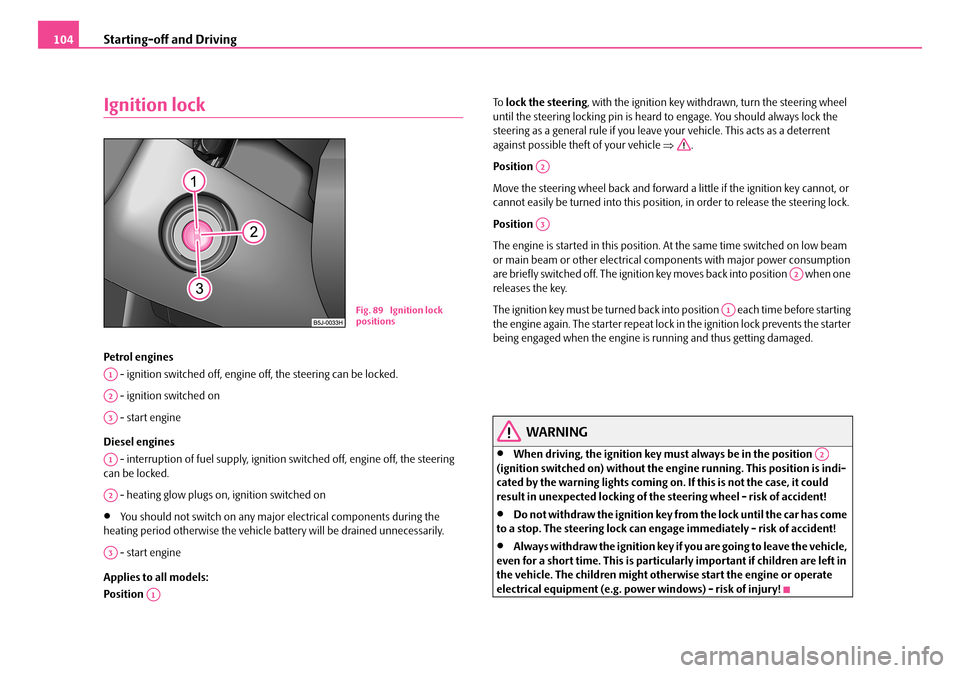
Starting-off and Driving104
Ignition lock
Petrol engines
- ignition switched off, engine off, the steering can be locked.
- ignition switched on
- start engine
Diesel engines
- interruption of fuel supply, ignition switched off, engine off, the steering can be locked.
- heating glow plugs on, ignition switched on
•You should not switch on any major electrical components during the heating period otherwise the vehicle ba ttery will be drained unnecessarily.
- start engine
Applies to all models:
Position
To lock the steering, with the ignition key withdrawn, turn the steering wheel until the steering locking pin is heard to engage. You should always lock the steering as a general rule if you leave your vehicle. This acts as a deterrent against possible thef t of your vehicle ⇒.
Position
Move the steering wheel back and forward a little if the ignition key cannot, or cannot easily be turned into this position, in order to release the steering lock.
Position
The engine is started in this position. At the same time switched on low beam or main beam or other electrical co mponents with major power consumption are briefly switched off. The ignition key moves back into position when one releases the key.
The ignition key must be turned back into position each time before starting the engine again. The starter repeat lock in the ignition lock prevents the starter being engaged when the engine is running and thus getting damaged.
WARNING
•When driving, the ignition key must always be in the position (ignition switched on) without the engine running. This position is indi- cated by the warning lights coming on. If this is not the case, it could result in unexpected locking of the steering wheel - risk of accident!
•Do not withdraw the ignition key from the lock until the car has come to a stop. The steering lock can enga ge immediately - risk of accident!
•Always withdraw the ignition key if you are going to leave the vehicle, even for a short time. This is particularly important if children are left in the vehicle. The children might othe rwise start the engine or operate electrical equipment (e.g. power windows) - risk of injury!
Fig. 89 Ignition lock positions
A1
A2
A3
A1
A2
A3
A1
A2
A3
A2
A1
A2
NKO A05Fabia 20.book Page 104 Tuesday, September 26, 2006 8:38 AM
Page 107 of 258

Starting-off and Driving106
Diesel engines
Glow plug system
Diesel engines are equipped with a glow plug system, the preglow period being controlled automatically in line with the coolant temperature and outside temperature.
The preglow indicator light comes on after the ignition has been switched on.
You should not switch on any major electrical components during the heating period otherwise the vehicle battery will be drained unneces- sarily.
•You should start the engine immediately after the glow plug warning light has gone out.
•The glow plug warning light will come on for about one second if the engine is at a normal operating temperature or if the outside temperature is above +5°C. This means that you can start the engine right away.
•Interrupt the attempt at starting after 10 seconds if the engine does not start right awayand wait for about 30 seco nds before repeating the attempt.
•It is possible that the fuse on the diesel preglow system is defect if the engine still does not start. Check th e fuse and replace it if necessary ⇒ page 235.
•Contact the nearest specialist garage to obtain professional assistance.
Starting the engine after fuel tank has run dry
It may take longer than normal to start th e engine after refuelling if the fuel tank has run completely dry - up to one minute. This is because the fuel system must first of all be filled while the attempting to start the engine.
Switching off the engine
– The engine can be sw itched off by turning the ignition key from
position ⇒page 104, fig. 89 into position .
WARNING
•Never switch off the engine before the vehicle is stationary - risk of accident!
•The brake booster only operates when the engine is running. Greater physical effort for braking is required when engine is switched off. Because if you do not stop as normal, this can cause an accident and severe injuries.
Caution
you should not switch the engine off righ t away at the end of your journey after the engine has been operated for a length y period at high loads but should be allowed it to run at idling speed for about 2 minutes. This prevents any accumu- lation of heat when the engine is switched off.
Note
•The radiator fan may continue running for a further 10 minutes or so after the engine and the ignition have been switched off. The coolant fan may, however, also switch on again after some time if the coolant temperature rises because of an accumulation of heat in th e engine or if the engine is warm and the engine compartment is additionally heated by strong sunlight.
•This is why particular care is requir ed when carrying out any work in the engine compartment ⇒page 198, “Working in the engine compartment”.
A1
NKO A05Fabia 20.book Page 106 Tuesday, September 26, 2006 8:38 AM